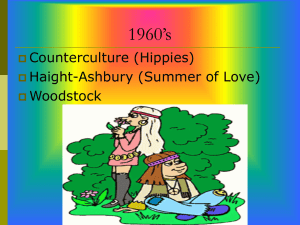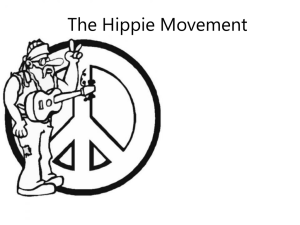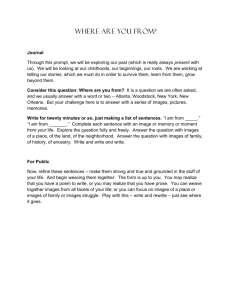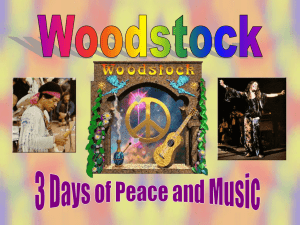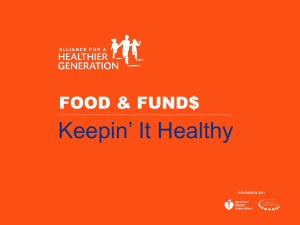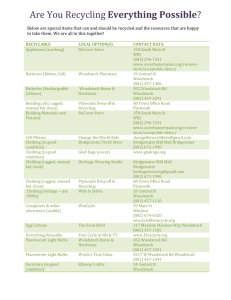The Woodstock music festival is a symbol of the counterculture and
advertisement
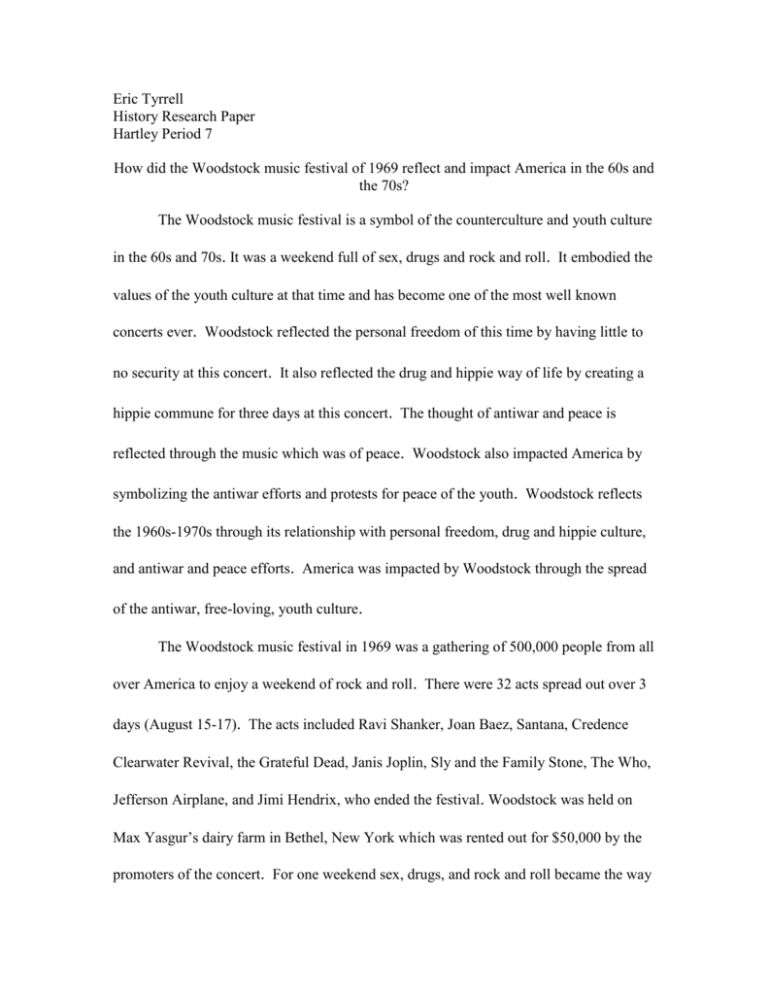
Eric Tyrrell History Research Paper Hartley Period 7 How did the Woodstock music festival of 1969 reflect and impact America in the 60s and the 70s? The Woodstock music festival is a symbol of the counterculture and youth culture in the 60s and 70s. It was a weekend full of sex, drugs and rock and roll. It embodied the values of the youth culture at that time and has become one of the most well known concerts ever. Woodstock reflected the personal freedom of this time by having little to no security at this concert. It also reflected the drug and hippie way of life by creating a hippie commune for three days at this concert. The thought of antiwar and peace is reflected through the music which was of peace. Woodstock also impacted America by symbolizing the antiwar efforts and protests for peace of the youth. Woodstock reflects the 1960s-1970s through its relationship with personal freedom, drug and hippie culture, and antiwar and peace efforts. America was impacted by Woodstock through the spread of the antiwar, free-loving, youth culture. The Woodstock music festival in 1969 was a gathering of 500,000 people from all over America to enjoy a weekend of rock and roll. There were 32 acts spread out over 3 days (August 15-17). The acts included Ravi Shanker, Joan Baez, Santana, Credence Clearwater Revival, the Grateful Dead, Janis Joplin, Sly and the Family Stone, The Who, Jefferson Airplane, and Jimi Hendrix, who ended the festival. Woodstock was held on Max Yasgur’s dairy farm in Bethel, New York which was rented out for $50,000 by the promoters of the concert. For one weekend sex, drugs, and rock and roll became the way of life. Despite food shortages, a lack of shelter, and the absence of police at the site the crowd managed to live in relative harmony (Cullen 2). A hippie commune was formed on the farm complete with a free food tent and a school for the children. There was also a hospital separated into three tents, one tent for people having a “bad trip” from hallucinogenic drugs, another for people’s feet that had been cut by rocks or broken glass. The final tent was for people who burnt their eyes by lying down and staring at the sun which is common for people who were “tripping” on drugs (Santos 1). Woodstock is regarded as a defining moment of the counterculture movement and was centered on the message of “peace and music.” Woodstock came at a time when the youth of America wanted complete personal freedom to do whatever they wanted. Young people, usually coming from middle class families, would leave their homes to search for enlightenment and to live in hippie communities. They sought an escape from the unacceptable norms of American life (Donato 1). This behavior by the American youth “symbolized the departure from the highly conservative, traditional, primarily Christian morals and customs of previous generations of Americans.” (Donato 1) The communities that they would join embraced free-love, the recreational use of drugs, and rock and roll. The capital of these communities was the Haight-Ashbury District in San Francisco. In this old neighborhood, residents had a lot of personal freedom and embraced alternative lifestyles with outlandish clothing, liberal sexual practices, communitarian philosophies, and rampant drug use (Raymond 2). Since the stress of working at a traditional job was abandoned in these communities, money was scarce. The residents found it profitable to manually raise and preserve food; repair vehicles, clothing, and shelters; and scavenge building materials, auto parts, used clothing, and sundry household items from the extreme waste created by the consumer economy (Hodgdon 5). When Woodstock came in the late 60s, the young people that were living in these communities traveled from all over America to go see the festival and created one of these communities during the festival. There was little to no police or security and the attendees had the freedom to do whatever they wanted. Woodstock attracted a very unique group of young people and with them they brought their culture to life at Woodstock. The hippie culture embraced the vision of a changed world that was built on peace and love. Even before Woodstock, hippies were having concerts that represented their culture; they were called “love-ins” or “be-ins”. These love-ins were gatherings of tens of thousands to listen to rock and roll that expressed messages of love, harmony, and peace. The hippie style was considered outrageous by the rest of America. America was able to see the hippie style in full effect through these love-ins. “On the day of a love-in, the hippies would emerge from the Haight in tie-dyed T-shirts, beads, peace symbols, flowing skirts, and velvet dresses, and drive in gaily painted Volkswagen vans to the Fillmore Auditorium or an antiwar protest at Golden Gate Park” (Barnhill 1). Woodstock can be considered the biggest love-in. The recreational use of drugs greatly influenced the hippie culture. People believed that mind altering drugs would unlock the door to peace and spiritual enlightenment (Donato 1). The most commonly used drug was marijuana, which contains tetrahydrocannabinol or THC. THC stimulates the brain and distorts time and space perception (Donato 2). It also has calming effects which makes it perfect for the hippie lifestyle. Another popular drug used by the hippies was LSD. This mind altering drug had extreme hallucinogenic effects and was used by hippies to experience spiritual enlightenment. It was even endorsed by a Harvard psychologist, Timothy Leary, who told his students to “turn on, tune in, and drop out.” He was later fired from his job for distributing LSD to students (Donato 2). Many hippies were first turned on by LSD at “Acid Tests” in San Francisco, where LSD flowed and sometimes was put into Kool-Aid. LSD gave rise to the psychedelic culture of the hippies. It influenced the type of clothing they wore and the type of music they listened to. Music was also greatly influenced by LSD. This type of music became known as “acid rock”. This music was played throughout the Woodstock festival and so did the use of LSD and marijuana. Woodstock was created to show how people should live, with peace and love, and most of the youth culture at Woodstock opposed the war in Vietnam. The hippie rejection of the traditional culture, including the Vietnam War, resulted in a natural affinity with the antiwar movement (Hunt 9). One of the most influential singers/song writers of the time was Bob Dylan. He sang of songs of social protest and was very popular amongst the hippies. Antiwar protests were held throughout America, a lot of them happening on college campuses. They were also held during love-ins where people would get up on stage and chant or give antiwar speeches. Another influential group in the time period was the Youth International Party or the Yippies. Created by Abbie Hoffman and Jerry Rubin, the Yippies “attempted to bridge the antiwar movement and counterculture.” (Hunt 10) These radicals wanted to change the message of the hippies from peace and love to revolution and protest. They wanted America to turn into a huge hippie community, this reflected in the Yippie Manifesto which was a list of demands that they thought should be made. Some of the demands were “immediate end to the war in Vietnam…abolition of a military draft…legalization of marijuana and all other psychedelic drugs…total disarmament of all of the people beginning with the police… the abolition of money… and the abolition of employment” (Yippie 3). Obviously none of these demands were made by the government and were “never taken seriously by many older activists” (Gworek 2). Woodstock was based on peace and love because the people at the concert were opposed to the War in Vietnam. Musicians at the festival had to sing at least one song against the war to play at Woodstock. The Woodstock festival was the ultimate climax of youth culture during the 1960s, but the antiwar and peace movement had a big impact on the 1970s and modern America. This counterculture movement started in California and spread all over the United States. The media covered the “love-ins” and other protests. The hippie style lasted a long time. People still grow out there hair and wear tie-dyed shirts. Recreational drug use is still extremely popular all over America today. Acid rock paved the way for other types of music in later decades, but the music made back then is still popular today. Footage from Woodstock has been put together into a movie called Woodstock (Dodgson 1). Also there were two more Woodstock festivals in 1994 and 1999, but they did not have as much success as the first one did. Overall Woodstock was a very influential and definitive moment in the late 1960s. The people at Woodstock started trends and sought a new lifestyle. They experimented with all sorts of mind altering drugs and protested American traditions and the Vietnam War. Rock and roll changed because the influence of drugs and became acid rock. Woodstock kept the message of peace and love the entire way through and will be forever remembered as one of the best rock concerts of all time. Bibliography Barnhill, John. "Love-Ins." Postwar America. Sharpe Online Reference (2010): n. pag. Web. 09 Jun. 2010 <http://www.sharpe-online.com/SOLR/a/showcontent/fullarticle/6/book006-PART1-article331>. Cullen, Jim. "Woodstock Music Festival Marks the Climax of 1960’s Youth Culture." Great Events from History: The Twentieth Century, 1941-1970. Ed. Robert F. Gorman. 1 vols. Pasadena, CA: Salem Press, 2008. Salem History Web. 09 Jun. 2010. Dodgson, Rick. "Woodstock." Dictionary of American History. Ed. Stanley I. Kutler. 3rd ed. Vol. 8. New York: Charles Scribner's Sons, 2003. 523-524. Gale Virtual Reference Library. Web. 27 May 2010. <http://go.galegroup.com/ps/i.do?&id=GALE%7CCX3401804590&v=2.1&u=s0003&it =r&p=GVRL&sw=w>. Donato, A. N. "Hippies and the Counterculture Movement." Drugs and Society. Marshall Cavendish Digital, 2010. Web. 09 June 2010. <http://www.marshallcavendishdigital.com/articledisplay/3/3475/35013>. Gworek, Benjamin. "Yippies." Postwar America. Sharpe Online Reference (2010): n. pag. Web. 09 Jun. 2010 <http://www.sharpe-online.com/SOLR/a/showcontent/fullarticle/6/book006-PART1-article593>. Hodgdon, Tim. "Counterculture Movement, 1960s–1970s." Encyclopedia of American Social Movements. Sharpe Online Reference (2010): n. pag. Web. 09 Jun. 2010 <http://www.sharpe-online.com/SOLR/a/show-content/fullarticle/2/book002-PART13article15>. Hunt, Andrew. "Antiwar Movement: Vietnam War." Encyclopedia of American Social Movements. Sharpe Online Reference (2010): n. pag. Web. 09 Jun. 2010 <http://www.sharpe-online.com/SOLR/a/show-content/fullarticle/2/book002-PART3article7>. Raymond, Emilie. "Counterculture." Postwar America. Sharpe Online Reference (2010): n. pag. Web. 09 Jun. 2010 <http://www.sharpe-online.com/SOLR/a/showcontent/fullarticle/6/book006-PART1-article125>. Santos, Richard. "Woodstock Music Festival." Postwar America. Sharpe Online Reference (2010): n. pag. Web. 09 Jun. 2010 <http://www.sharpeonline.com/SOLR/a/show-content/fullarticle/6/book006-PART1-article589>. Yippie, A. "YIPPIE MANIFESTO ARTIFACT." The Yippie /Zippie Website! Web. 10 June 2010. <http://yippiemuseum.org/manifesto.htm>.

